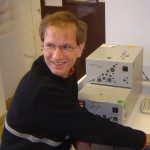Link to Pubmed [PMID] – 23604351
Sci Rep 2013;3:1690
SUMO-modified proteins are recognized by SUMO interacting motifs (SIMs), thus triggering diverse cellular responses. Here SIMs were used to develop SUMO-traps to capture endogenous SUMOylated proteins. Our results show that these small peptides are transferable motifs that maintain their SUMO binding capacity when fused to the heterologous carrier protein GST. The tandem disposition of SIMs increases the binding capacity of SUMO-traps to specifically interact with polySUMO but not poly-Ubiquitin chains. We demonstrate that this SUMO capturing system purifies SUMOylated proteins such as IκBα, PTEN, PML or p53 in vitro and in vivo. These properties can be used to explore the many critical functions regulated by protein SUMOylation.

